Birdwaiting in the Darien
The famed Darien Gap, the only break in the Panamerican Highway between Alaska and the southern tip of South America. Whenever I heard anything about it at home, it was always related to some danger lurking within. I pictured a dense, impenetrable jungle that was full of militia, drug operations, malaria-carrying mosquitos, and more recently, people whose lives were so terrible they were braving a very long walk through this dangerous region, many dying along the way.
While to one extent or another some of that is certainly real (and heartbreaking), that isn’t the whole story. The Darien province is also home to several villages, a large national park, and by far the smoothest part of the Panamerican highway between Panama City and the highway’s end. We could see the dark hills from San Blas, and our guidebook indicated that this very much off the beaten path area could be visited. Intriguing, but it sounded difficult to visit, with advance permits needed from both the border police and the national park. There was precious little information available about how to do any of this, and we weren’t convinced there was a compelling reason to figure it all out. So we somewhat reluctantly wrote it off. But then, we learned that the only place in Central America to see the harpy eagle is in Darien National Park. This eagle, Panama’s national bird, is widely considered to be the most powerful eagle on earth. And, our guide in Gamboa had recently heard about a harpy eagle chick on the nest whose mom visited most days to feed. Woah. That was game over for me. We simply had to go, despite running out of time in Panama to do so. Peter remained on the fence, but I was convinced I could get him off if I could figure out the logistics.
As luck would have it, on our last night in Gamboa we had dinner with a serious birder who had a trip planned to the Darien in a few weeks! I contacted her guide, figured out a date, and voila, we had a plan and someone to handle all the logistics! The only remaining challenges were, we had to rebook flights and lodging to extend our stay in Panama for 4 days, and I had to convince Peter that this made sense (“we’re spending two full days of uncomfortable travel and how much money to see…a bird?” “This is hardly ‘a bird,’ there is far more to see, and it’s never free to travel to the remote places,” etc. etc.). I got him there eventually, as I knew I would 😉
Day 1 of 4: We were to be picked up at 5:30 a.m. as we had to get to the Rancho Frio ranger station in the national park, where we’d spend three nights. It was a long trek, involving a long and frequently rough truck ride, a boat ride, another truck ride, a walk in very muddy conditions in our brand new Colombian-made rubber boots, and a four-wheeler ride on a muddy track, all of which would take at least eight hours. At 5:25 a.m., Peter reached for the elevator button in our building and his back spasmed. He could barely walk. This couldn’t be happening. There couldn’t be worse timing on this trip. But it was happening, and he barely made it to the awaiting truck.
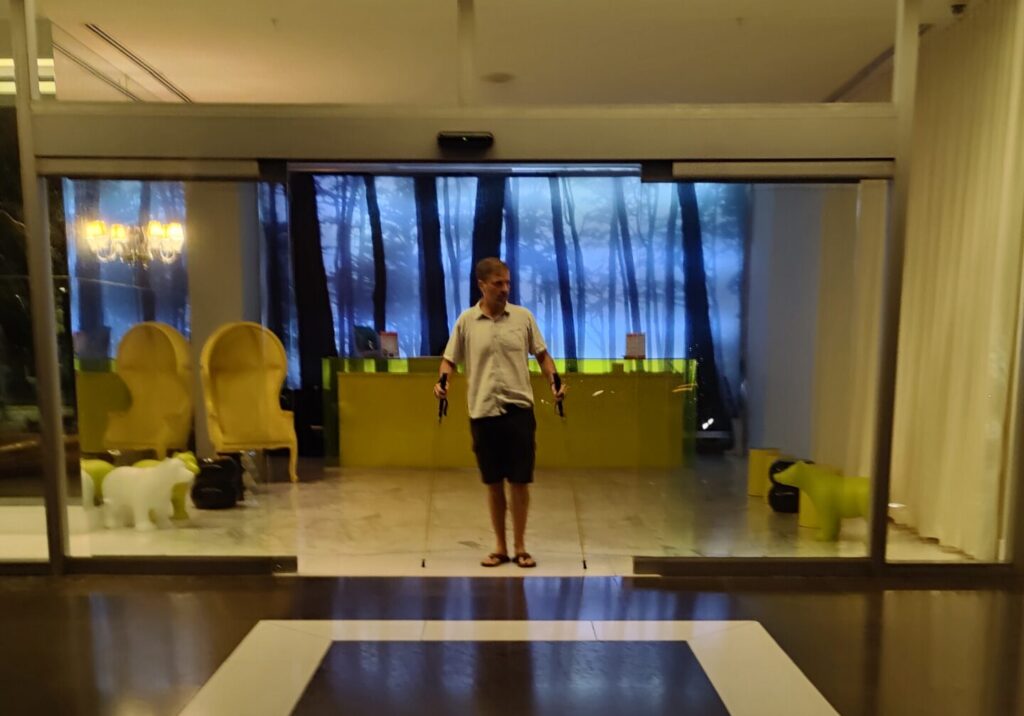
As luck would have it again, our driver was an off-duty border police commandante with bad knees and an anti-inflammatory cream in the back of his truck. We’d never heard of this drug, but it helped a great deal. With Peter uncomfortably but successfully inside the truck, off we went on the first leg of this very long travel day. By the time we reached the town of Yaviza, which marks the end of the Panamerican highway, we had stopped at several checkpoints run by the regular and border police to show permits. In Yaviza, we left the road behind and boarded a boat for a 30-minute ride on a river mostly bordered by jungle en route to the very small village of El Real.
Here we were picked up by our commandante again, this time in a different truck, to take us the rest of the way to the edge of the national park. A park ranger on a four-wheeler was waiting there to take our bags and food to the station. Given his situation, Peter decided to ride on the four-wheeler too, while Isaac and I walked part of the way. The track/trail had areas of deep mud and it sloped from one side to the other in several places. When the four-wheeler came back for us some 45 minutes later, I was happy to see it. I realized shortly after getting on the four-wheeler that walking had been far more comfortable. But, I now have an entirely new appreciation for what a four-wheeler can get through without getting stuck or tipping over. All told, the trip took us about 9.5 hours to complete; for Peter, it probably felt like 95. The ranger station accommodations were very rustic, as expected (think terrible mattresses, one tiny fan, no A/C, no hot water, bucket flush toilets, and bad but edible food), but on the bright side we had an overhead shower with cold water from the river piped in by PVC, clean sheets, and new mosquito nets that tucked in properly. And we had made it! We were exhausted and went to bed directly after dinner.
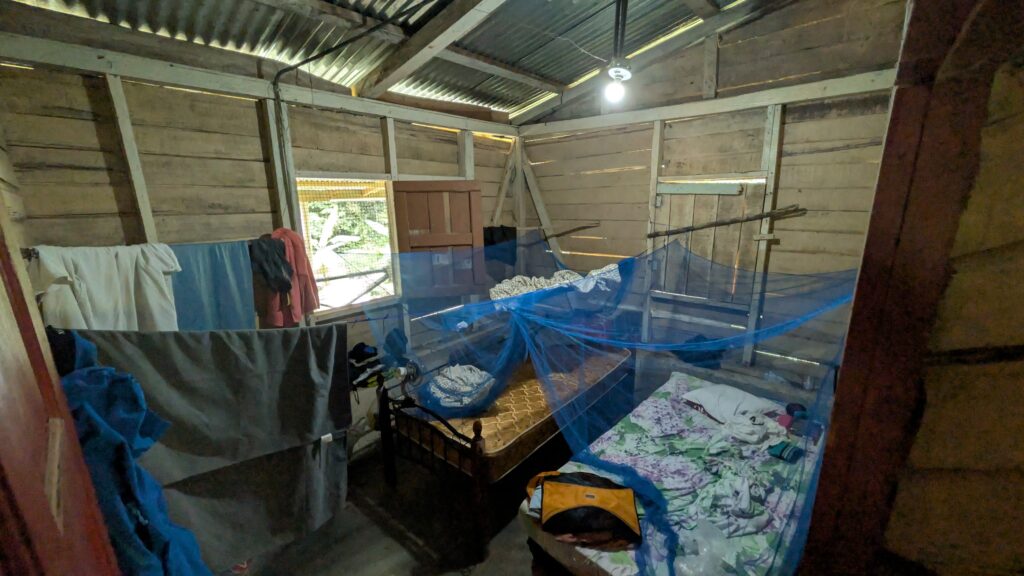
Day 2: The day dawned hot and sunny. Although a far cry from feeling great, Peter could walk slowly. After all he had endured the day before, he wasn’t about to stay back and miss the eagle, so we set out about 8:00 with Isaac and arrived at The Spot about 45 minutes later. It was very muddy and on a hill, but the rangers or guides had laid down a few logs to sit on, which resting spots turned out to be much needed.
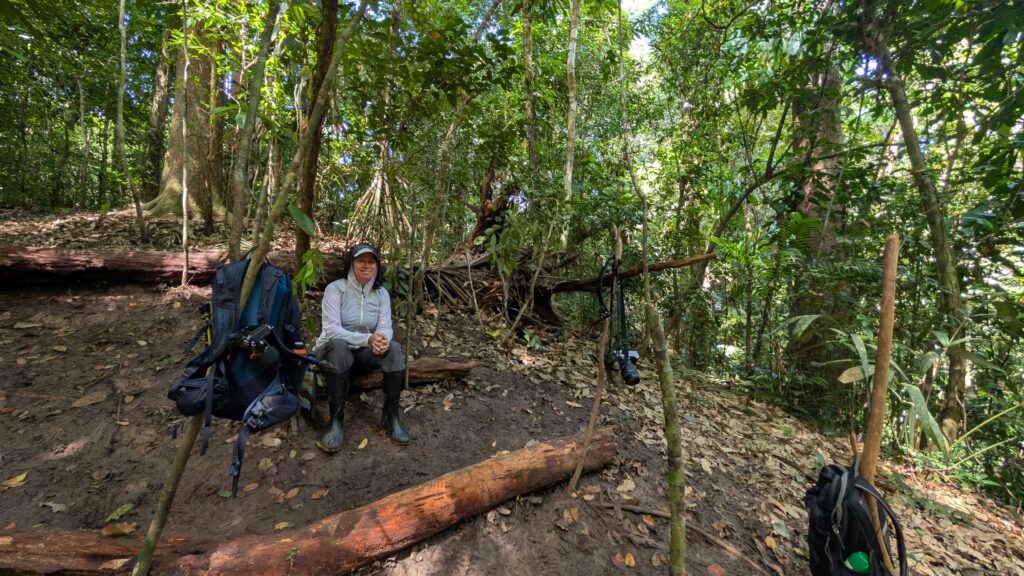
We had a clear view of the nest from here. From time to time the chick would move, maybe even flap her (we decided it was a girl chick) wings, which was momentarily exciting. In between chick movements, we waited. And waited. No mama bird came, but the mosquitos certainly did. I had almost forgotten how uncomfortable it was to wear long pants, a long-sleeved shirt, and a hat with a bug net in high heat and humidity. As late morning is the most common time to see the mom, at noon we gave up and went back to the station for a bad lunch.
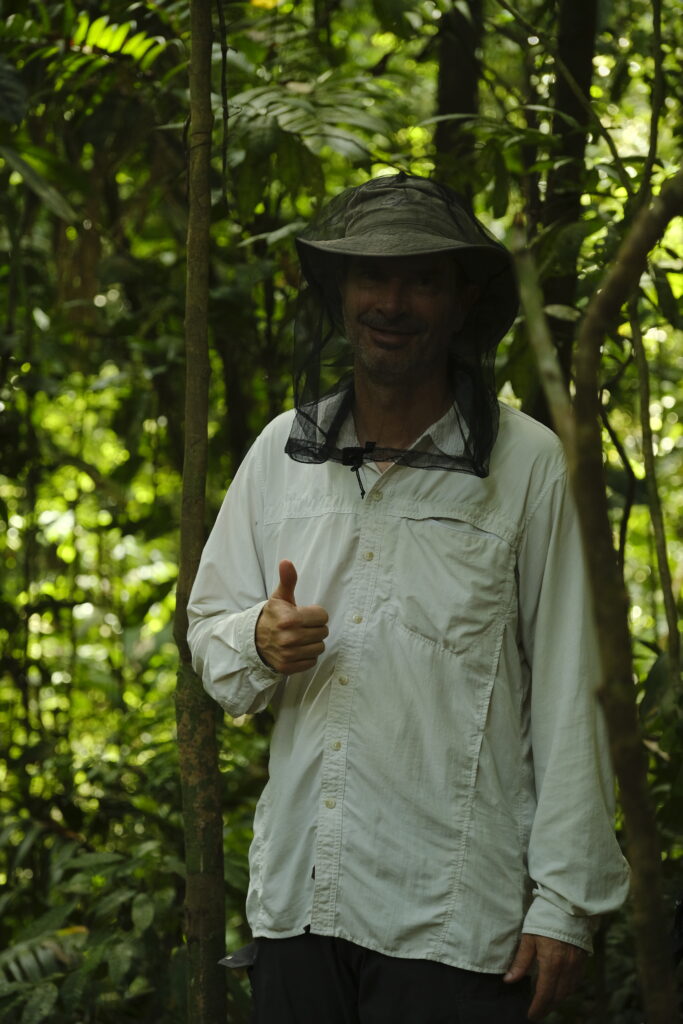
Later that afternoon, Isaac and I went for a long walk and saw many other birds, while Peter hung out at the station and heard the life story of Norberto, the resident head ranger, complete with phone photos going back years.
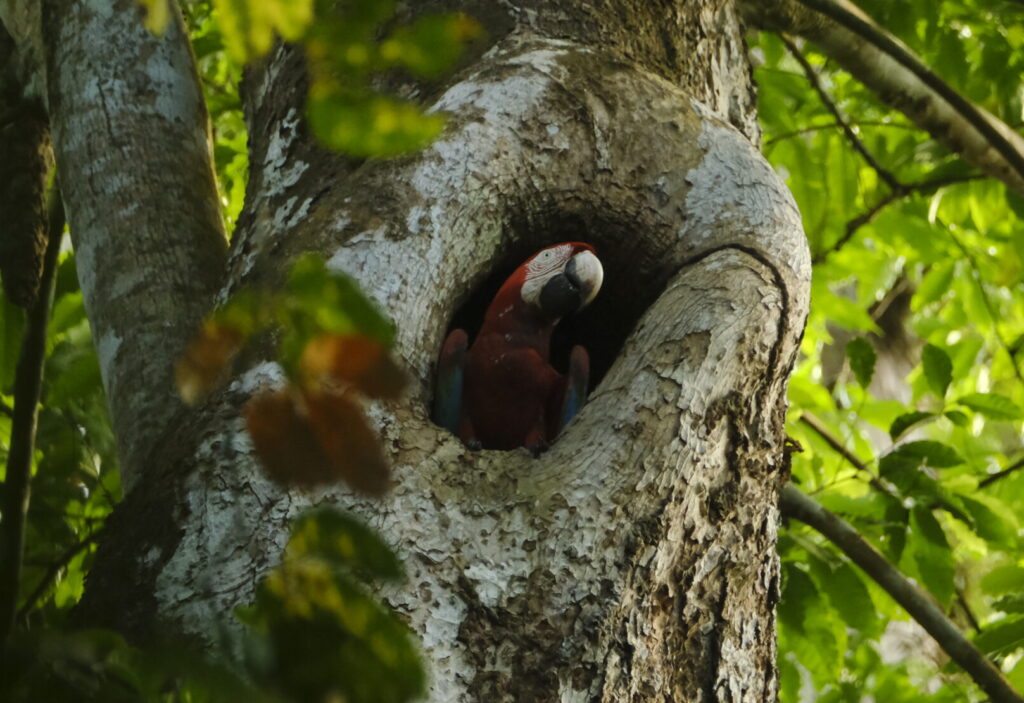
The big news was that Norberto was now cooking for us, which was odd but fantastic – he was a great cook! I don’t know where he got ham, or what all went into his delicious tangerine sauce for that ham, but it was a far cry from the stir fried canned tuna mixed with canned peas and corn of the evening before. Well fed and full of hope for tomorrow, everyone went to bed about 8:00 pm, with a plan to leave no later than 7:00 the next morning to go back to the nest and continue waiting.
Right after we went to bed, it started to rain. Then it started to thunder, and pour on our metal roof. Then lightning struck right outside the building and the accompanying thunder was deafening. As I lay waiting for hail to start up and come crashing through the roof, I realized rain already was, right onto my mattress. Awesome. Well, we wanted an adventure.
Day 3: We woke up to learn there was no water, the storm had blocked or broken the pipes in the river. More awesome. Undeterred after a Norberto breakfast, by 7:30 back we were with the mosquitos and the chick. This time, we were joined for some time by a flock of parrots who were eating these “coco” fruits in the big tree above us, which made a huge racket and caused the baseball-to-softball-sized thick, hard fruit shells to come crashing down to the ground regularly right around us. Somehow we were missed. This activity punctuated the relative monotony of watching various birds fly by and chirp or screech, hearing howler monkeys in the distance, and watching Peter do wall sits against a tree to stretch his back. There are far worse ways to spend a day, I kept telling us both. The chick was a little more active (hungrier?), but by 11:30 there was again no sign of mom.
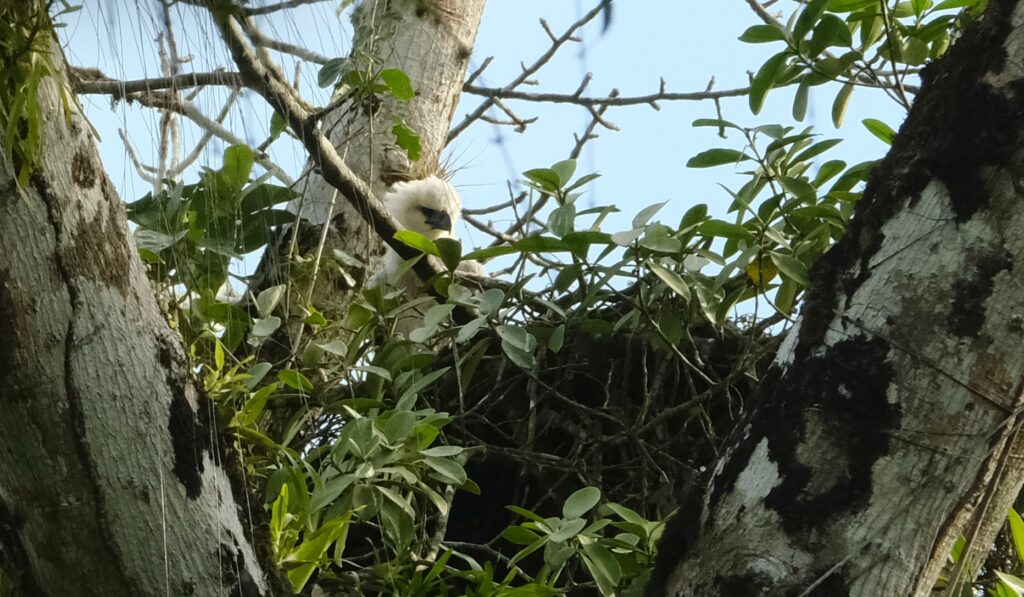
Confident she would come today, Isaac went back to the station, returning later with coffee and a delicious lunch, along with news of no water yet (“will it be fixed today?” “Yes yes, in about an hour, maybe 2”). We continued to wait, as my own confidence started to waiver. I started thinking there was no way the water was getting fixed, no way we were seeing this bird today, and no way Peter was ever going to let me talk him into something like this again. I was already negotiating with Isaac for a late start on the trip back the next day so we could come back for a few hours the next morning to birdwait, and he seemed to agree to it.
At 2:35 the chick started “peep-peep-peeping.” Isaac said somewhat blandly that it could be the mom, and to watch to the right as she always approached from that direction. After a few minutes, like when the music tempo in a movie picks up, there were more “peep-peep-peeps,” closer together, and we all perked up. Discouragingly, there was no answering call from mom. But Isaac, with ever increasing earnestness in his voice, urged us to keep watch to the right. I became cautiously hopeful, a bit on the edge of my log seat. And then, at 2:48, suddenly there she was, that magnificent bird, looking every bit the apex predator that she is. Not a real birder either, I was surprised at how awestruck I was to see this eagle, she was just so impressive to watch. As to no answering call, I suppose her chick knew her mom by sight as no other bird in that sky approaches a female harpy eagle in terms of size, not even the male harpy eagle. She was at the nest for just over 10 minutes, moving around a bit, and we could see her most of that time. We learned later that another group only got to see her head, and obviously some people don’t see her at all. We were so lucky!
Back to camp we went to discover the water had actually been fixed! More luck! We took much needed showers to cool off, read books for a few hours, and had a delicious final meal prepared by Norberto, including some “Panamanian special beefsteak” for just me and Peter (there was no freezer, where did he get this beef?!). No storms that night, but tiny bugs that can get through the mosquito nets but do not carry disease bit the bejeezus out of both of us while we slept.
Day 4: We said goodbye to Norberto after eating “artesanal tortillas” for a very early breakfast, and reversed Day 1’s trek. We arrived in Panama City around 4:00, where we checked into a Marriott and enjoyed air conditioning, hot showers, flush toilets, and pasta and pizza for dinner.
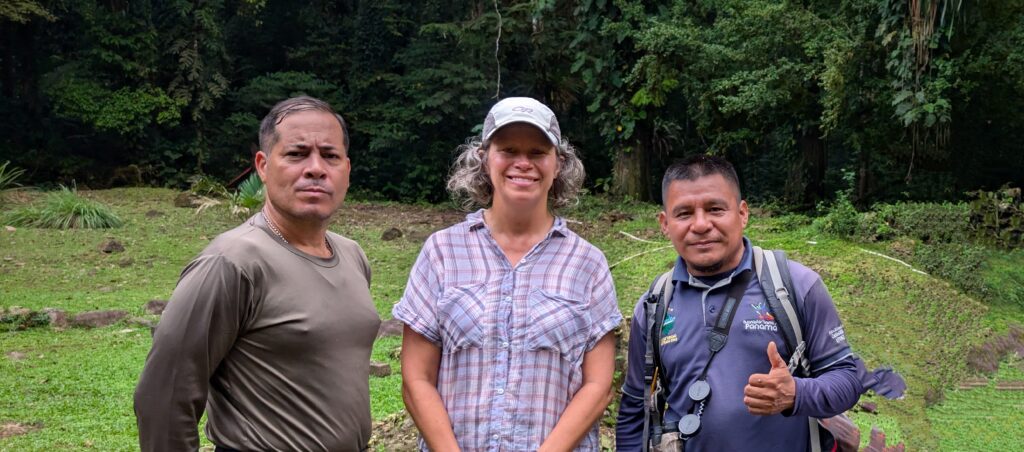
And therein ends my tale of the harpy eagle, and our trip to Panama. We really liked Panama, and over our two-month visit we realized we drove (or were driven) the entire Panamerican highway from the Costa Rican border where we rafted, to the end of the road in Yaviza. It’s a beautiful country with everything from volcanos to jungles to beaches, lots of wildlife, and generally good infrastructure. It’s not very touristy in most places, and it’s easy to get basically anything you need or want in Panama City. Panamanians are friendly and welcoming (greeting and saying goodbye each time someone enters and exits an elevator!) and the good coffee is really, really good. I think we’ll come back someday, but for now, it’s on to the higher altitude of San Jose, Costa Rica, for a ten-day welcome break from Panama’s heat and humidity.
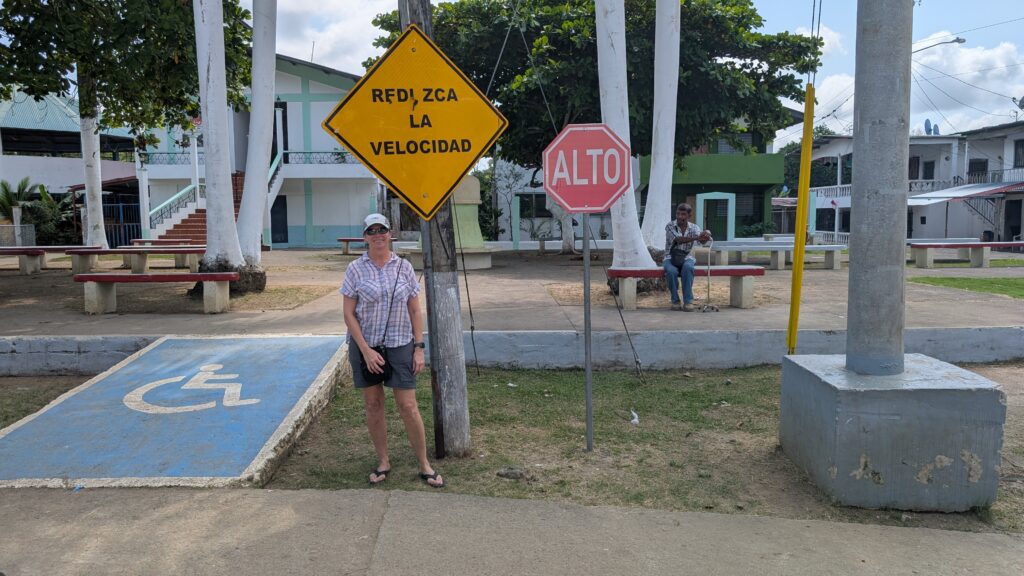
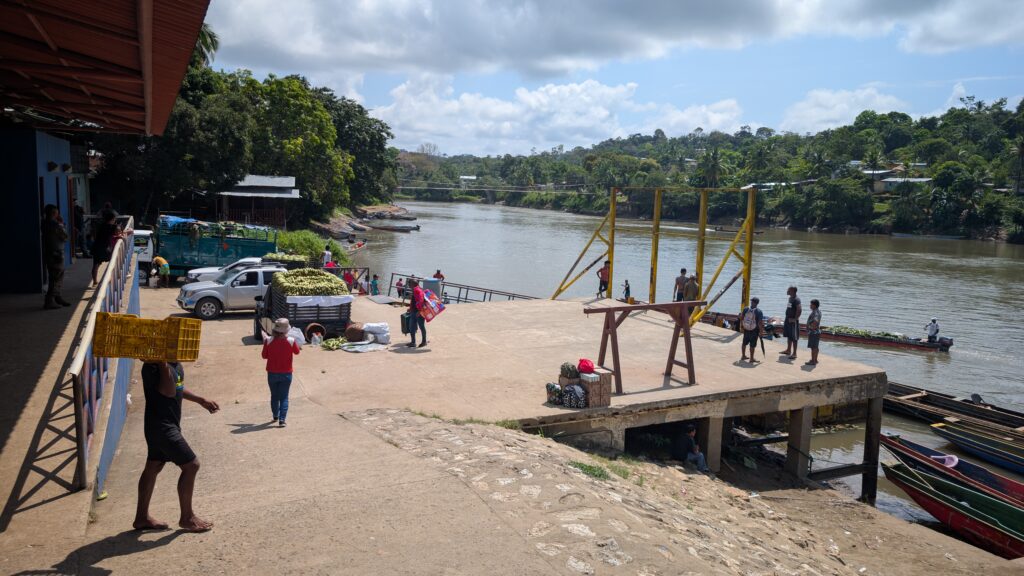
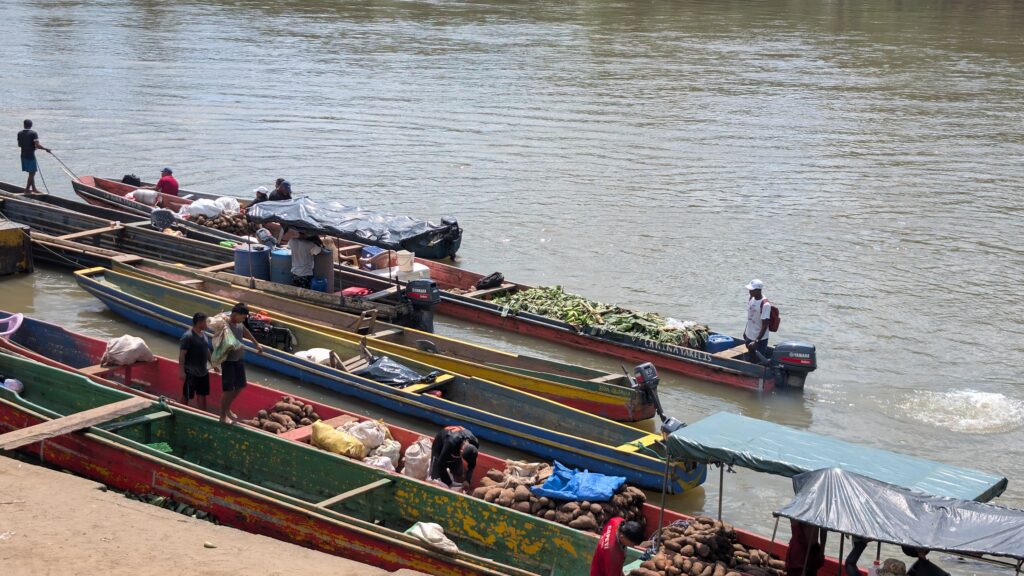
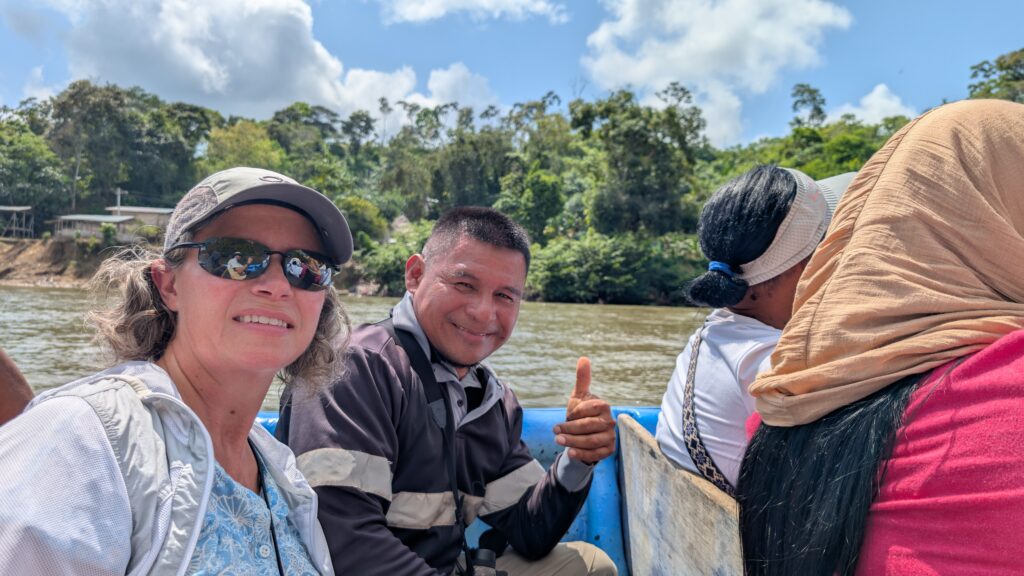
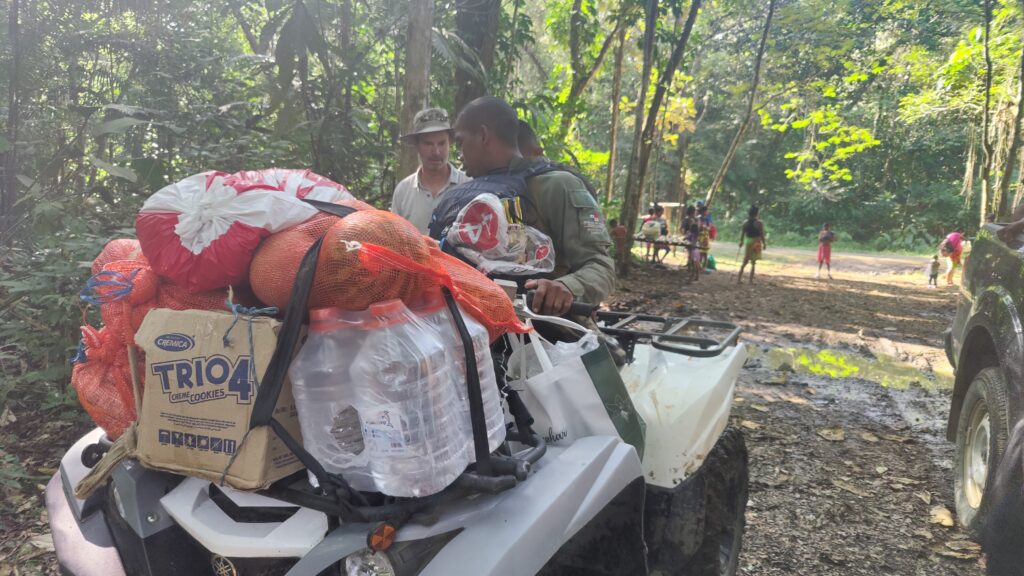
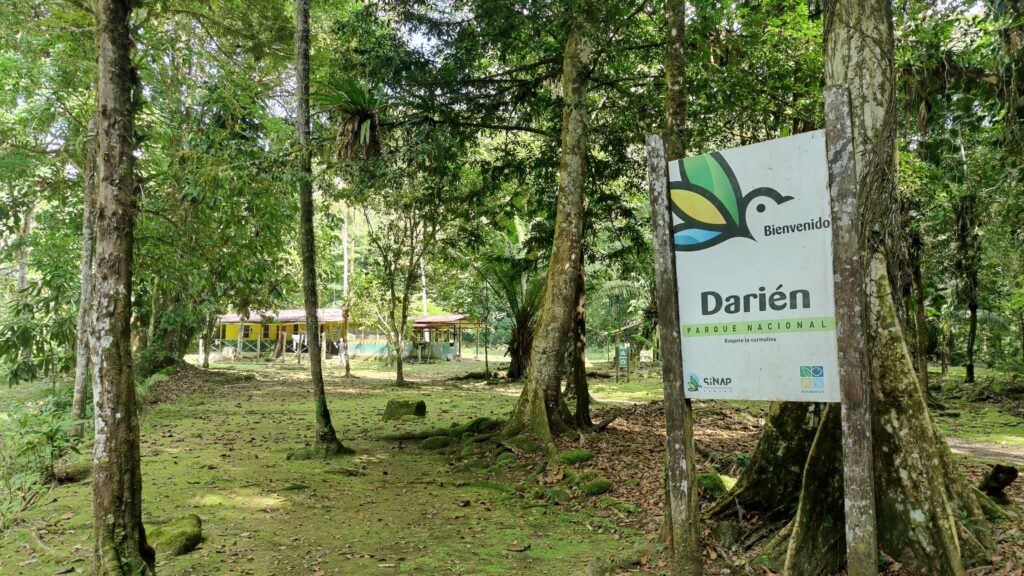
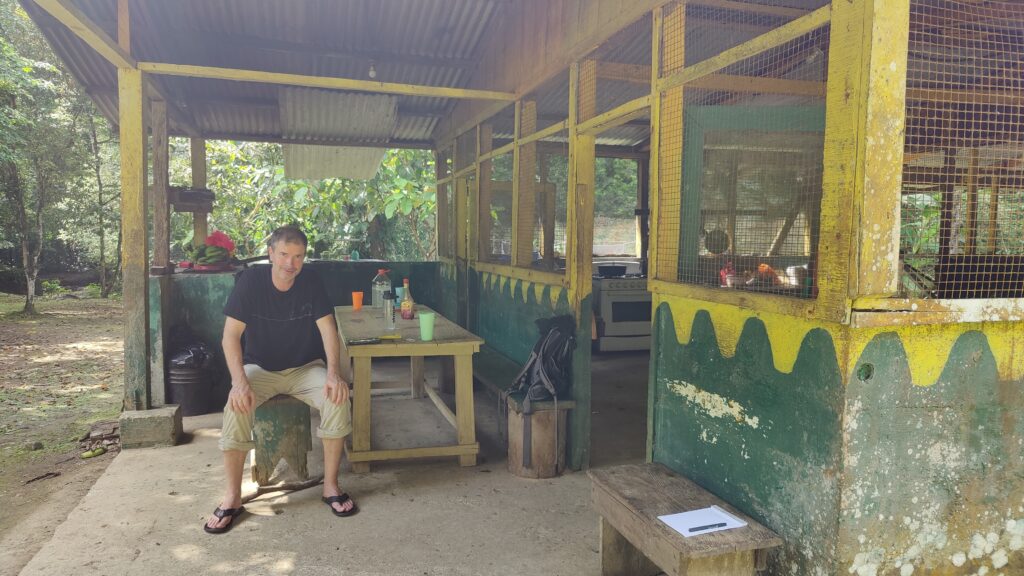
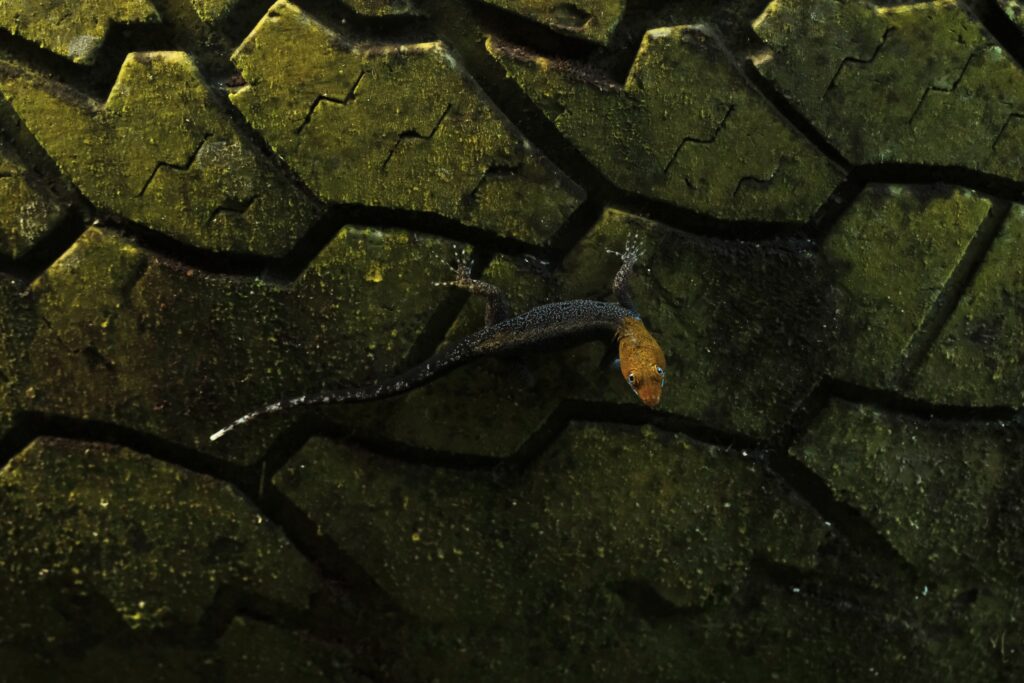
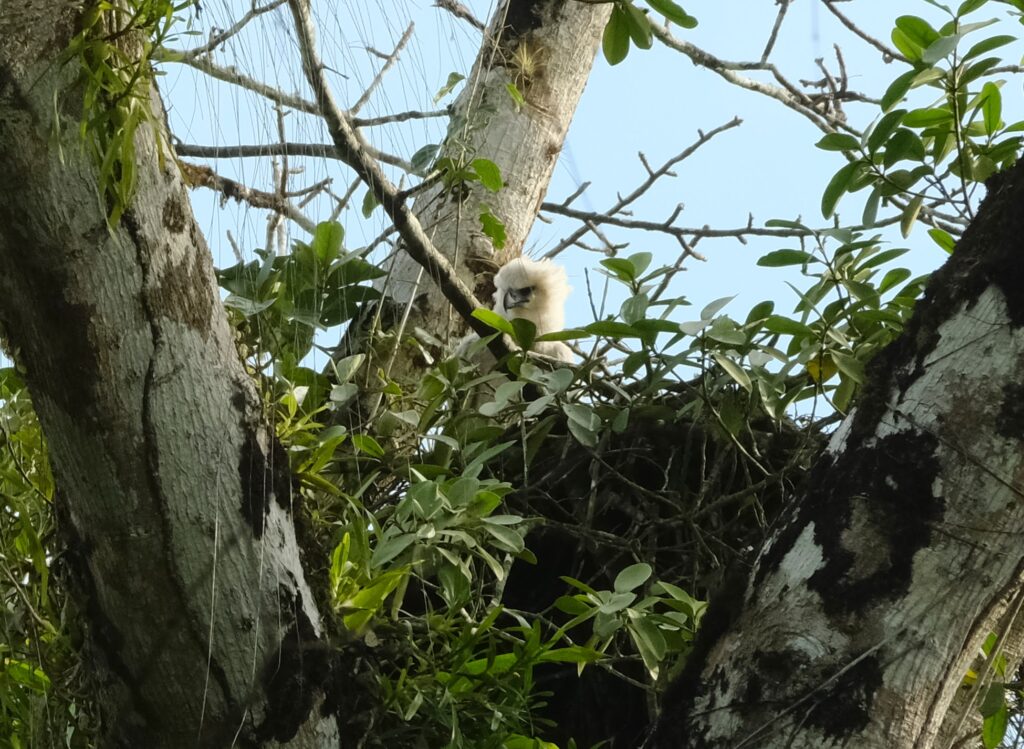
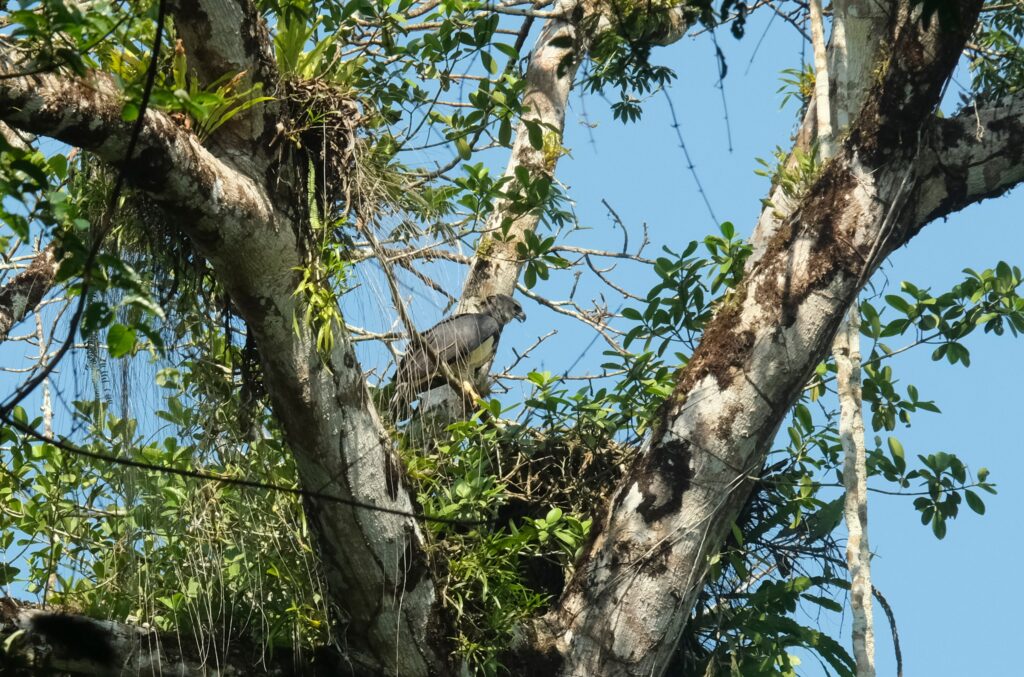
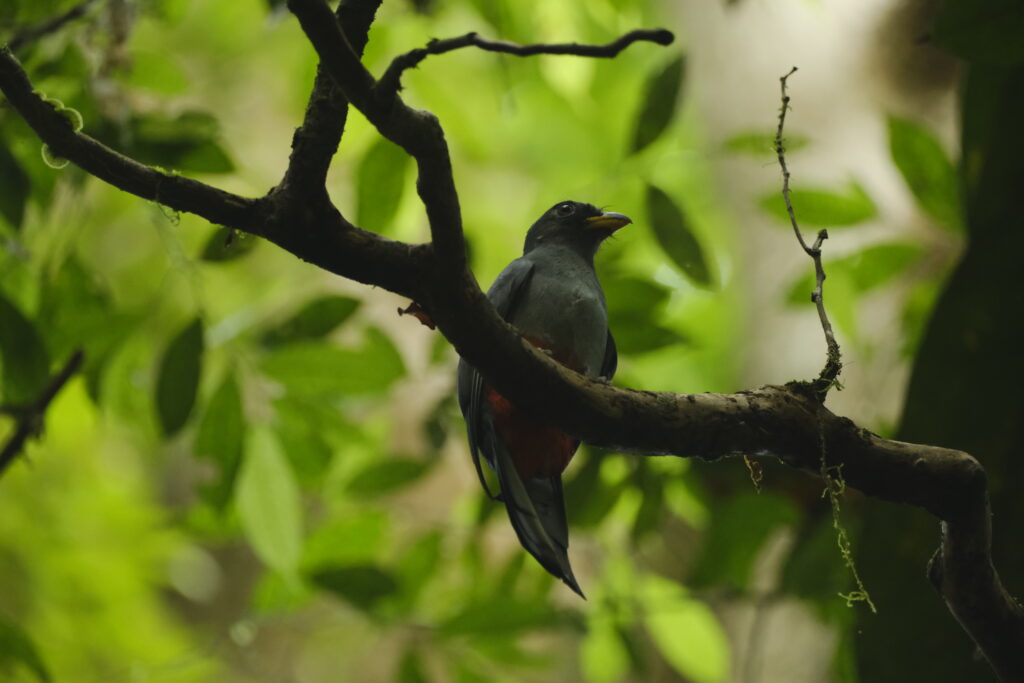
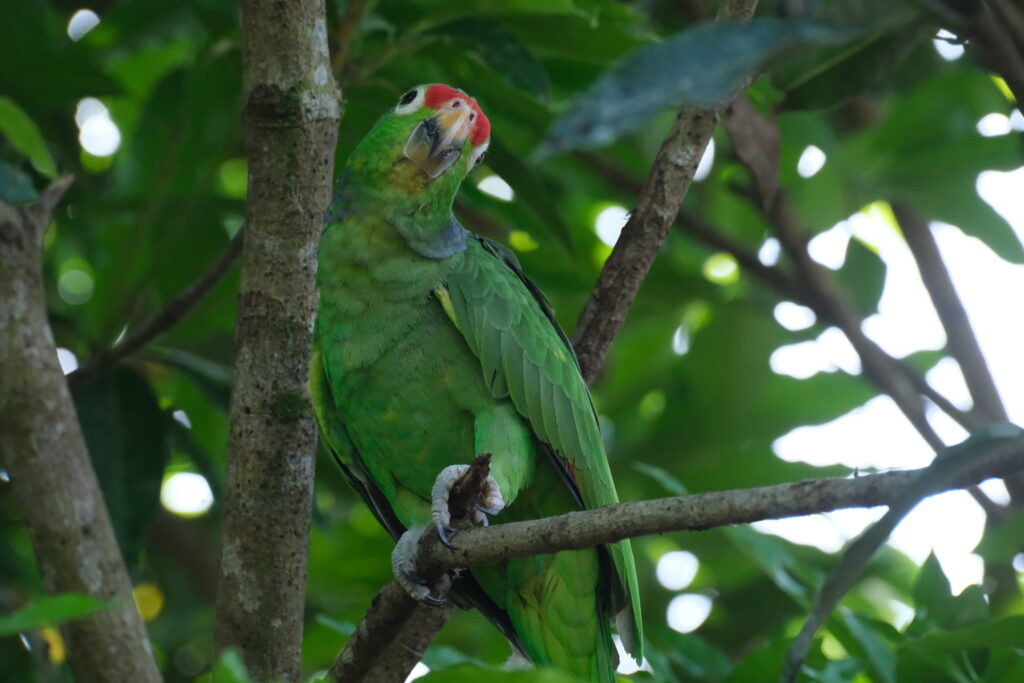
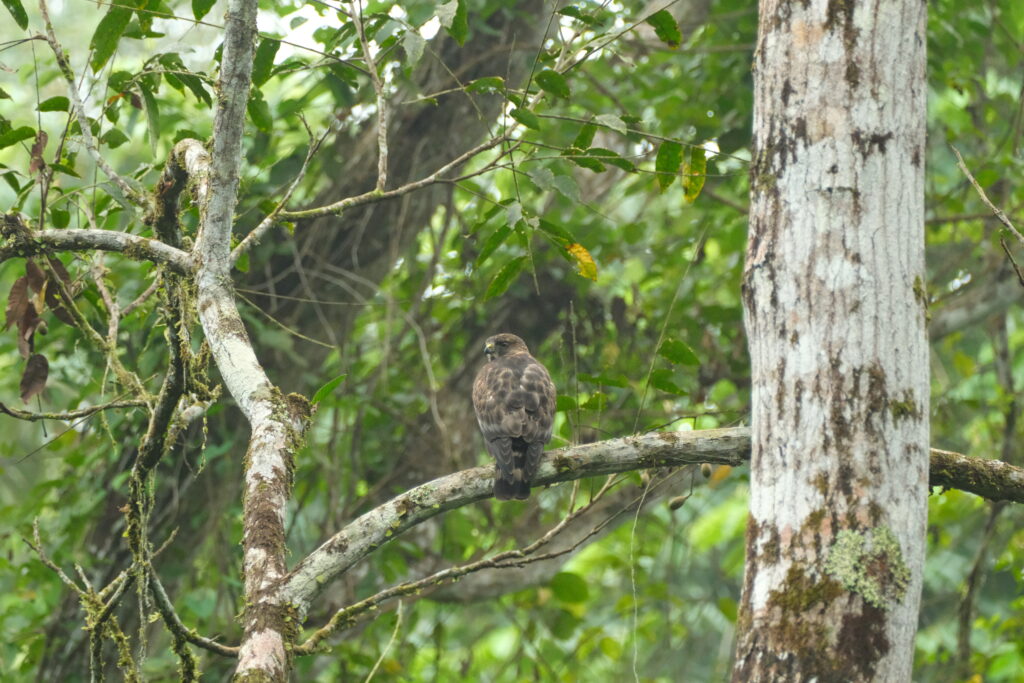
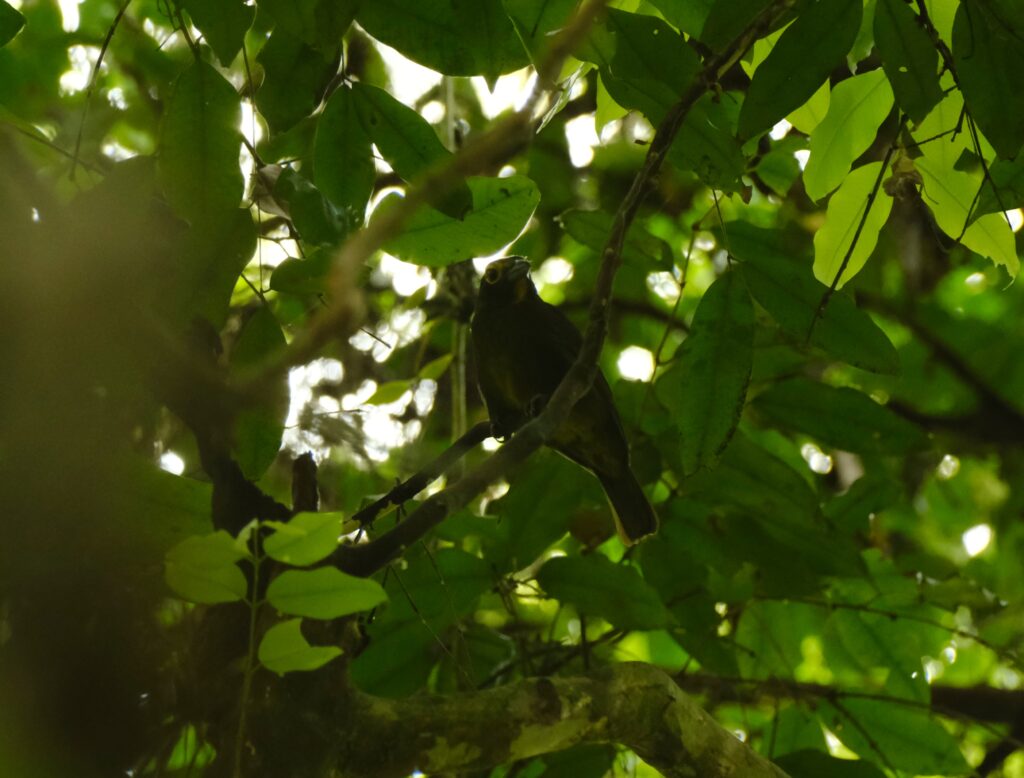
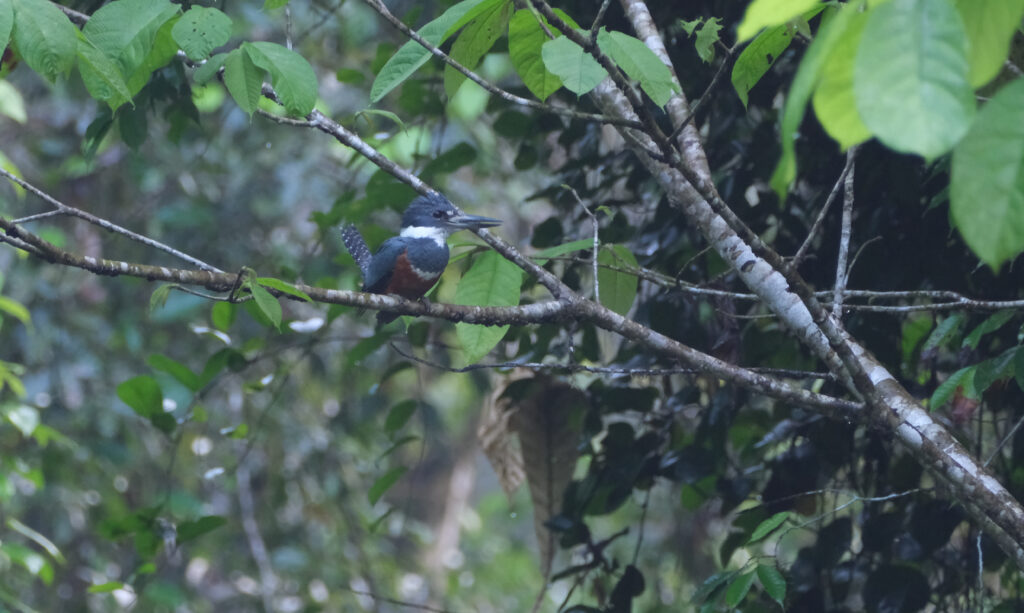
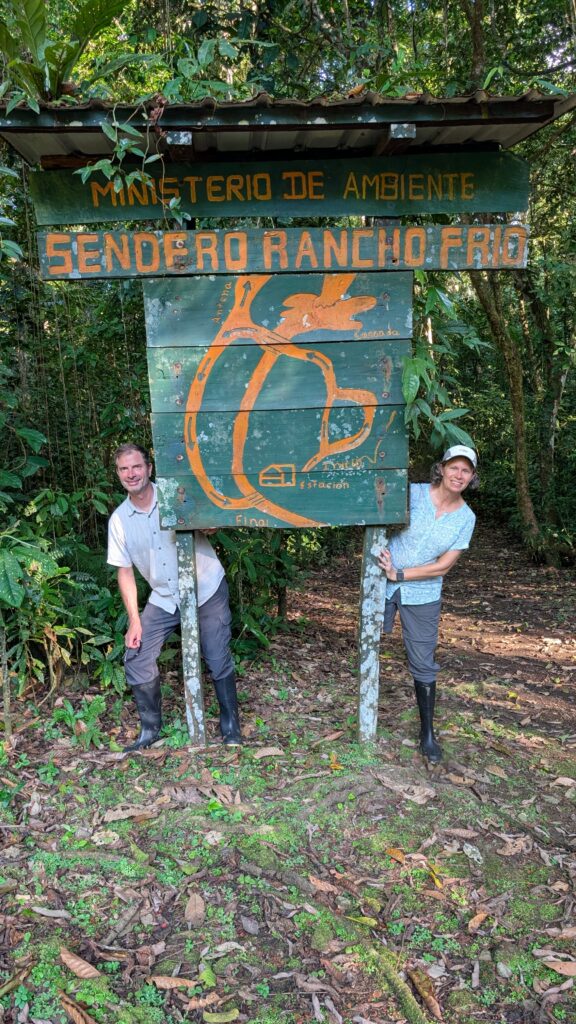
Categories: Uncategorized
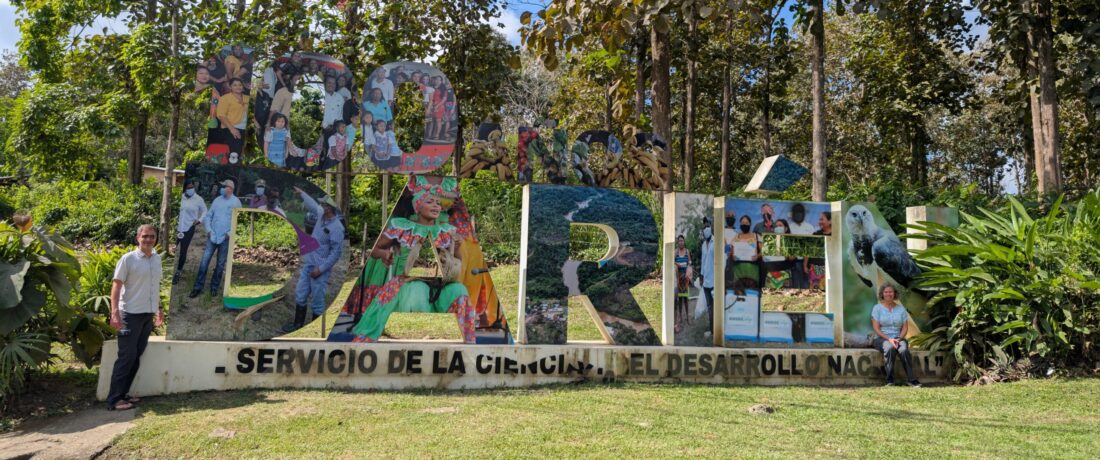
Well, that story makes my day. I am a birder and would put up w/ all that (and more) to see a Harpy Eagle. What counts as “seeing” a bird might only be a 2 second glimpse. This was luxurious, more like “studying” the bird. Granted that it was a 4 day investment, but that just makes it more special. Serious birders go to great lengths and spend big money. At some point each new bird costs $1000.
We have all the info you need to plan your trip, Wren! Including a less rustic but more expensive option 🙂
Hi Denise and Peter:
Thank you for your write-up – it made my day! I just found a good online comparison between Harpy Eagles and Bald Eagles: https://a-z-animals.com/animals/comparison/harpy-eagle-vs-bald-eagle/. I spent time in Boquete in 2012 to see if I might want to move there, but lack of dual citizenship prevented it at the time. I hope to have it soon, so I could re-visit the possibility. Wishing you a great time in Costa Rica as we go through a cold spell with snow next week.
Sabine
That’s a good comparison, thanks for sharing! We were wondering where you were looking back in 2012, Boquete makes sense.
What an awesome experience and story! Peter, I’m glad you were able to tough it out! Interestingly, in just the past couple days I heard a “Bird Note” episode on Seattle’s KNKX (NPR affiliate) which featured the Harpy Eagle. I’m not much of a birder, but I thought, “Oooh, that’d be interesting to see.” And here you two are, galivanting around in Darien and got to see one! I think there is far more than “luck” at play in your adventure! 🙂
What crazy timing for that episode! She is definitely a bird worth seeing 🙂
You just keep making Cozumel look better and better! But I’m so happy you enjoy this so I can live vicariously through you, explore through your journaling and know where I don’t need to spend money going to.
Stay safe, watch out for those snakes and don’t eat any poisonous mushrooms!
XOXO
As previously discussed 🙂 , Cozumel has something for everyone! 2025?
I was exhausted after reading about your adventure, patiently wanting to see the Harpy Eagle!! The weather and accommodations you dealt with..wow!! Stay safe on your travels. Enjoy Costa Rica!
What an interesting adventure! My son is helping a family who crossed the Darien Gap (basically walked from Venezuela) to escape a really unsafe situation. That’s all we knew about the Darien Gap, was there horrible journey. So nice to see/read about some beautiful encounters there!
I knew nothing about the Harpy Eagle and now I am fully enlightened! How cool!
Keep the stories coming!!
-sara
Oh wow Sara, that’s incredible that he’s helping a family who made it. I can’t even imagine how bad things would have to be to attempt that kind of journey on foot, as you say. I hope things turn out for them!
*their horrible journey, not “there”.. Oh grammar…
What an adventure, guys! It felt like I took the journey with you. Glad all the effort paid off in the end. The video of the harpy eagle is breathtaking.
Even more impressive is Denise being able to wait for so long with a disabled Pete. 🙂
From the article comparing the bald and harpy eagle, it seemed obvious why one is “bald”. But apparently, “balde” is an old English word for white. So much to learn from the peteanddenise blog!
Nice job labeling all the birds.
Thanks for the feature request, Sam – we do our best to please 🙂
What a great adventure! Thanks for sharing.
What a great adventure to watch while the snow is piling up with below 0 windchills. Looking forward to seeing the next one!